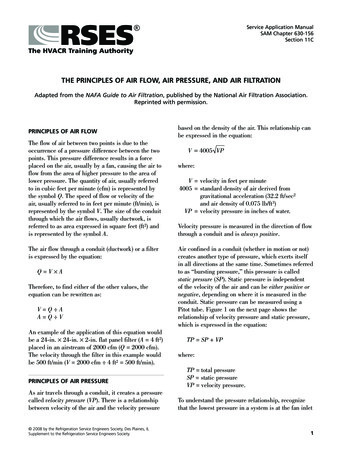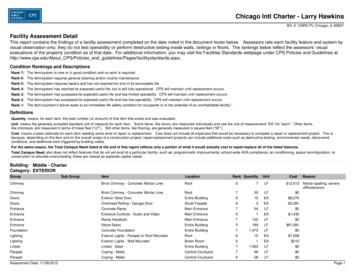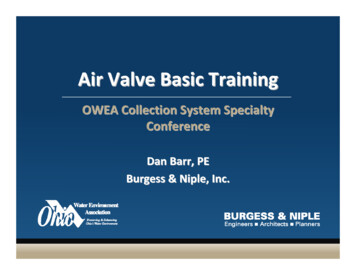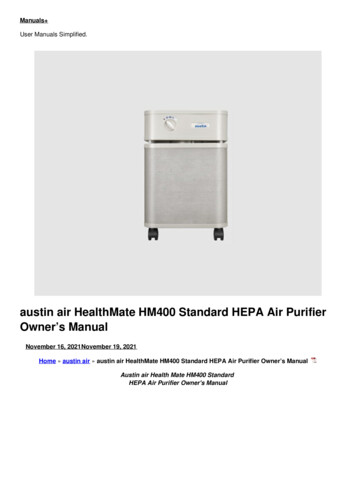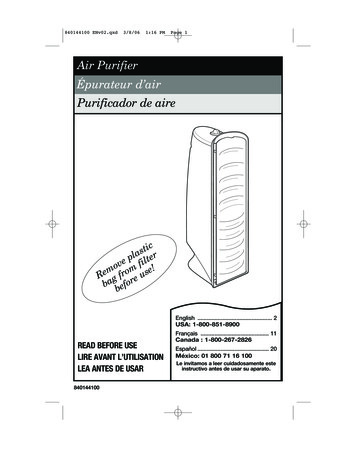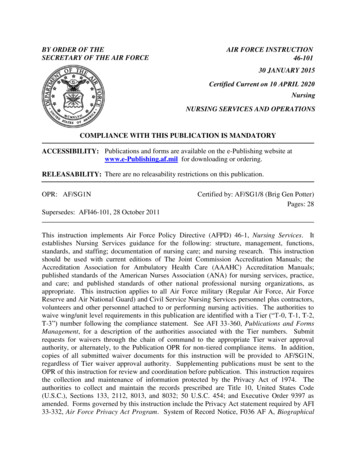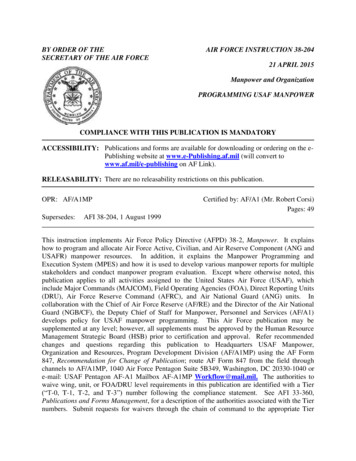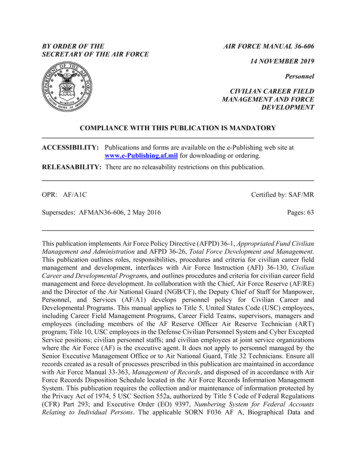
Transcription
BY ORDER OF THESECRETARY OF THE AIR FORCEAIR FORCE MANUAL 36-60614 NOVEMBER 2019PersonnelCIVILIAN CAREER FIELDMANAGEMENT AND FORCEDEVELOPMENTCOMPLIANCE WITH THIS PUBLICATION IS MANDATORYACCESSIBILITY: Publications and forms are available on the e-Publishing web site atwww.e-Publishing.af.mil for downloading or ordering.RELEASABILITY: There are no releasability restrictions on this publication.OPR: AF/A1CSupersedes: AFMAN36-606, 2 May 2016Certified by: SAF/MRPages: 63This publication implements Air Force Policy Directive (AFPD) 36-1, Appropriated Fund CivilianManagement and Administration and AFPD 36-26, Total Force Development and Management.This publication outlines roles, responsibilities, procedures and criteria for civilian career fieldmanagement and development, interfaces with Air Force Instruction (AFI) 36-130, CivilianCareer and Developmental Programs, and outlines procedures and criteria for civilian career fieldmanagement and force development. In collaboration with the Chief, Air Force Reserve (AF/RE)and the Director of the Air National Guard (NGB/CF), the Deputy Chief of Staff for Manpower,Personnel, and Services (AF/A1) develops personnel policy for Civilian Career andDevelopmental Programs. This manual applies to Title 5, United States Code (USC) employees,including Career Field Management Programs, Career Field Teams, supervisors, managers andemployees (including members of the AF Reserve Officer Air Reserve Technician (ART)program; Title 10, USC employees in the Defense Civilian Personnel System and Cyber ExceptedService positions; civilian personnel staffs; and civilian employees at joint service organizationswhere the Air Force (AF) is the executive agent. It does not apply to personnel managed by theSenior Executive Management Office or to Air National Guard, Title 32 Technicians. Ensure allrecords created as a result of processes prescribed in this publication are maintained in accordancewith Air Force Manual 33-363, Management of Records, and disposed of in accordance with AirForce Records Disposition Schedule located in the Air Force Records Information ManagementSystem. This publication requires the collection and/or maintenance of information protected bythe Privacy Act of 1974, 5 USC Section 552a, authorized by Title 5 Code of Federal Regulations(CFR) Part 293; and Executive Order (EO) 9397, Numbering System for Federal AccountsRelating to Individual Persons. The applicable SORN F036 AF A, Biographical Data and
2AFMAN36-606 14 NOVEMBER at:http://dpclo.defense.gov/Privacy/SORNs.aspx. The authorities to waive wing/unit levelrequirements in this publication are identified with a Tier (“T-0, T-1, T-2, T-3”) number followingthe compliance statement. See AFI 33-360, Publications and Forms Management, for a descriptionof the authorities associated with the Tier numbers. Route waiver requests from the field throughthe chain of command to the appropriate Tier waiver approval authority, or alternately, to therequestor’s commander for non-tiered compliance items. This publication may be supplementedat any level; all Major Command (MAJCOM)-level supplements must be approved by the HumanResource Management Strategic Board (HSB) prior to certification and approval. Referrecommended changes and questions about this publication to the Office of Primary Responsibilitylisted above using AF Form 847, Recommendation for Change of Publication.SUMMARY OF CHANGESThis publication has been substantially revised and should be completely reviewed. Major changesinclude removal of all individual career field (CF) chapters. Chapters submitted by Career FieldManagers (CFM) may be viewed on the CFM SharePoint site maintained by AF/A1CX, .mil/sites/11547/ .aspxChapter 1—ROLES AND RESPONSIBILITIES51.1.Assistant Secretary of the Air Force (Manpower and Reserve Affairs) (SAF/MR).51.2.Deputy Chief of Staff, Manpower, Personnel and Services (AF/A1). .51.3.Director, Civilian Force Management (AF/A1C). .51.4.Director, Airman Development (AF/A1D). .51.5.Director, Equal Opportunity (AF/A1Q). .51.6.Air Education and Training Command Commander. .51.7.Air Force Personnel Center (AFPC) Commander. .51.8.Career Field Managers (CFMs). .51.9.Career Field Teams. .51.10.Functional Advisory Councils. .61.11.Development Teams (DT). .61.12.Local Base Training Offices. .6Chapter 2—Career Field Teams – Operations and Procedures2.1.Program Authorities. .77
AFMAN36-606 14 NOVEMBER 201932.2.General. .72.3.Coding Positions. .72.4.Position Classification. .72.5.Restructuring Positions. .8Chapter 3—Workforce Development93.1.Strategic Planning. .93.2.Tuition Assistance (TA). .93.3.PAQ/COP Programs. .123.4.Leadership Development. .133.5.Career Development Positions. .13Figure 3.1.Civilian Mobility Memorandum of Agreement to a Career Field Team CentrallyManaged Position (Note: Upon publication of AF Form 202, this agreement willbe rescinded and replaced by the new AF Form 202.).15Chapter 4—Participation304.1.Career Mobility. .304.2.Individual Development Plan. .314.3.Currency and Accuracy of Employee Data. .324.4.Affirmative Employment Program Planning. .33Chapter 5—Filling Positions345.1.Filling Centrally Managed Positions. .345.2.Methods of Filling Positions. .345.3.Requesting Fill Action. .365.4.Methods for Filling Unique Positions. .365.5.Missed Consideration from a Referral Certificate. .375.6.Overseas Employment. .375.7.PCS and Waivers to Service/Employment Agreement. .37Figure 5.1.CONUS Employment Agreement.425.8.PCS Funding and Allowances. .435.9.PCS Relocation Services. .46
4AFMAN36-606 14 NOVEMBER 20195.10.Career Field Team Training and Development Course Listing. .495.11.Career Paths. .495.12.Funding. .495.13.Continued Service Agreement. .505.14.Repayment of Training Funds. .505.15.Short-Term Training. .505.16.Long-Term Training. .505.17.Civilian Developmental Education. .50Chapter 6—Acquisition Professional Development Program (APDP)526.1.Concept. .526.2.Career Field Team Roles. .52Chapter 7—Grievances and Complaints537.1.Employee Complaints. .537.2.Settlement of Disputes. .53Chapter 8—Program Evaluation548.1.Periodic Evaluation. .548.2.Self-evaluation. .54Attachment 1—GLOSSARY OF REFERENCES AND SUPPORTING INFORMATION55Attachment 2—FIGURE A2.1. CIVILIAN FORCE DEVELOPMENT CAREERPLANNING DIAGRAM (NOTIONAL)62
AFMAN36-606 14 NOVEMBER 20195Chapter 1ROLES AND RESPONSIBILITIES1.1. Assistant Secretary of the Air Force (Manpower and Reserve Affairs) (SAF/MR).1.1.1. Serve as an agent of the Secretary of the Air Force (SecAF), providing guidance,direction and oversight for all matters pertaining to the formulation, review and execution ofplans, guidance, programs and budgets addressing AF civilian career field management.1.1.2. Review and provide AF concurrence/non-concurrence with the Department of Defense(DoD) civilian workforce-related plans and report presented to Congress.1.2. Deputy Chief of Staff, Manpower, Personnel and Services (AF/A1). Providemanagement, oversight, and administration of all civilian career field management programs andrequirements.1.3. Director, Civilian Force Management (AF/A1C).1.3.1. Provide regulatory guidance, direction and advice for civilian career field management.1.3.2. Integrate AF-wide civilian career field guidance with that of DoD, government-wideand similar programs.1.3.3. Serve as AF Component Integrator for development of DoD and AF civilian workforceplanning.1.4. Director, Airman Development (AF/A1D). Provide policy guidance and directionpertaining to civilian force development to assist career field management.1.5. Director, Equal Opportunity (AF/A1Q). Will develop and disseminate AF EqualOpportunity Program policy. (T-1). Will develop recommendations to enhance personnelprocesses affecting the recruitment, selection, utilization, training, and advancement opportunitiesof all AF personnel in accordance with AFI 36-2706, Equal Opportunity Program, Military andCivilian. (T-1).1.6. Air Education and Training Command Commander.As the Force DevelopmentCommander, executes the long-range strategic development of Total Force Airmen (Guard,Reserve, Regular AF and civilian) through a deliberate process that combines education, trainingand experiences to produce the right competencies to meet the AF’s operational needs. Willestablish the basic framework and processes to plan, build and execute competency models. (T1).1.7. Air Force Personnel Center (AFPC) Commander. Executes civilian force managementresponsibilities.1.8. Career Field Managers (CFMs). Will establish occupational competency models for usewithin their respective functional areas. (T-2).1.9. Career Field Teams. Will centrally administer managerial/leadership training anddevelopment for career field employees and centrally funded force renewal positions. (T-2). Thistraining and development includes selected career broadening and career enhancing assignments,job rotation, short- and long-term training, management and executive seminars, education and
6AFMAN36-606 14 NOVEMBER 2019self-improvement activities intended to systematically develop employees for filling AF positionsof increased responsibility.1.10. Functional Advisory Councils. Functional communities establish advisory councilschaired by the Functional Authority, or designee, to address unique functional needs.1.10.1. Functional Advisory Council Chairs may further designate individuals or groups tocarry out certain authorities. If so designated, a written record is maintained by the CareerField Team.1.10.2. Groups (panels) may be established to manage such areas as promotion plans, referralissues, positions, training, leadership development, workforce analysis and overall programeffectiveness.1.10.3. Panels meet on a regular and recurring basis. (Note: Some career fields haveDevelopment Teams in lieu of Functional Advisory Councils.)1.11. Development Teams (DT).1.11.1. Will provide mentoring and career advice to members of the career field through thevectoring process as well as rate candidates for developmental opportunities such as CareerBroadening, Civilian Developmental Education, Civilian Strategic Leader Program and/or keycareer positions. (T-2).1.11.2. Some career fields conduct combined officer and civilian DTs.1.11.3. Annual Force Development/DT guidance addresses DT rank structure and diversity ofteam composition. Refer to AFI 36-2640, Executing Total Force Development, for additionalinformation.1.12. Local Base Training Offices. Retain the responsibility for funding and administeringtactical level training, such as that required for job proficiency.
AFMAN36-606 14 NOVEMBER 20197Chapter 2CAREER FIELD TEAMS – OPERATIONS AND PROCEDURES2.1. Program Authorities. The AF fulfills Public Law 95-454, Civil Service Reform Act of1978, requirements for executive management through a series of functionally-orientedcareer field programs. Each career field program is administered by a Career Field Teamlocated within AFPC. Career Field Teams manage the careers of permanent civilians withintheir career field by developing highly competent leaders through a variety of training anddevelopmental programs. Career Field Teams also provide for the systematic developmentof potential candidates for Senior Executive Service/Defense Intelligence Senior ExecutiveService positions through various force development initiatives, to include participation inthe Civilian Strategic Leader Program and Key Civilian Programs. Additional informationabout Career Field Team objectives, structure and responsibilities is outlined in AFI 362640.2.2. General. The Functional Manager or designee shall establish criteria and providedirection to Career Field Teams on which positions will be centrally managed by the careerfield. (T-2). Career field centrally-managed positions are either competitive or exceptedservice permanent appropriated fund positions in the General Schedule and theirequivalents under other pay systems such as the Defense Civilian Intelligence PersonnelManagement System (DCIPS) and Acquisition Demonstration and LaboratoryDemonstration projects.2.3. Coding Positions. AF Career Field Managers (CFMs) shall designate centrally managedpositions within the career field unless delegated to the Career Field Team. (T-2). Theinstallation’s servicing classification function and the Career Field Teams will identify centrallymanaged career field positions by coding and maintaining position data in the civilian personneldata system. (T-2). These data fields include the Career Field Identifier, Career Field Type andMobility. Civilian Personnel Sections and/or the servicing classification function must verifycareer field centrally-managed coverage before filling vacancies. (T-3). The Career Field Teamand servicing Civilian Personnel Section will conduct periodic position reviews to identify andcorrect erroneous position coding. (T-2).2.3.1. Temporary and Term Positions. Temporary and Term positions are not centrallymanaged; therefore, centralized funding of Permanent Change of Station (PCS) costs is notauthorized.2.3.2. Over-hire Positions. Over-hire positions are not centrally managed; therefore, centralfunding of PCS costs is not authorized.2.3.3. Reimbursable Fund Positions. Reimbursable fund positions that are centrally managedare eligible for centrally funded PCS.2.3.4. ART Officer Positions. All ART officer positions are centrally managed by the ARTOfficer Career Management Program which is responsible for funding their PCS costs.2.4. Position Classification. Except as noted below, positions are classified by officesmaintaining classification authority for the installation or organization, to include servicingCivilian Personnel Sections, Major Commands (MAJCOMs)/Combatant Commands (COCOMs),AFPC, the Air Force Office of Special Investigations and Air Force Reserve Command
8AFMAN36-606 14 NOVEMBER 2019(AFRC)/A1C. When questions of consistency or standardization in classification arise, AFPCClassification Oversight decision is authoritative. AF/A1C will be the arbitrator and final decisionauthority for classification policy issues. (T-1). Other programs, to include the DCIPS,Acquisition Demonstration, Laboratory Personnel Demonstration Project and Cyber ExceptedService have their own classification authority (see AFI 36-1401, Civilian Position Classification).2.4.1. Career Broadening and Force Renewal Positions. AFPC, in coordination with CFMs,will classify career broadening and force renewal positions (Student Intern, Recent Graduates,PALACE Acquire (PAQ) and COPPER CAP (COP)) funded through the Central SalaryAccount. (T-2). Employees who accept a career broadening developmental assignment mustagree to pursue the objectives and activities specified in the developmental plan and corepersonnel document. (T-3). Changes to the established core personnel document are notauthorized for the duration of the career broadening assignment.2.4.2. Civilian Strategic Leader Program (CSLP). The CSLP is an AF enterprise CareerDevelopment Program and a component of the talent management strategy for strategic-levelleaders. The CSLP office serves as the focal point for all CSLP positions, facilitates theselection board process and manages the assignment process in coordination with the CareerField Teams.2.5. Restructuring Positions. Centrally managed positions are filled at the full-performancelevel unless a special need arises that requires filling the position below the target grade.2.5.1. Commanders/civilian equivalents will ensure that requests for approval toaccommodate a special needs situation(s) are made in advance, in writing, with justification,and directed through the respective Career Field Team to the Functional Manager or designee.(T-3).2.5.2. The Functional Manager may delegate the authority to approve restructuring a centrallymanaged position to the respective CFM or Career Field Team Chief.2.5.3. Restructured positions are advertised to the AF standard Area of Consideration: DoDwide, Transfer, Reinstatement, Interagency Career Transition Assistance Plan, VeteransEmployment Opportunities Act, Military Spouse and Schedule A eligibles in accordance withpara. 5.2.3.
AFMAN36-606 14 NOVEMBER 20199Chapter 3WORKFORCE DEVELOPMENT3.1. Strategic Planning. Career Field Teams shall provide assistance and information to theCareer Field Manager, Functional Manager and Functional Authority on the management of thetotal civilian workforce, including college recruitment, employee placement, development trends,hiring/promotion data, demographics, career progression and other relevant career fieldinformation. (T-2). Career Field Teams also must oversee the data management of the civiliancareer fields; develop and conduct studies of internal and external civilian career field trends;perform civilian career field research, analyses and surveys; and manage the development ofcivilian strategic and business plans. (T-2).3.1.1. Civilian Workforce Development Objectives are to create a strategy to effectivelydevelop leaders to meet mission requirements and efficiently use financial resources. Theworkforce strategy is to: 1) identify capabilities and talent requirements; 2) develop amanagement framework to meet force renewal, functional and corporate requirements; and 3)ensure the framework is flexible enough across career fields to meet unique missionrequirements.3.1.2. Efficient use of AF financial resources involves: 1) identifying the framework forexecuting financial resources/priorities; and 2) assessing an acceptable degree of risk and/oralternative funding.3.2. Tuition Assistance (TA). TA funds tuition and course-related fees for accredited collegeand university courses. It is distinguished from long-term training that is defined as training duringduty hours of over 120 consecutive days.3.2.1. Civilian Tuition Assistance Program (CTAP). AF civilian post-secondary TA isintended to support civilians in their continued self-development and includes coursework atthe associate, bachelor, master (including the Juris Doctorate) and doctoral levels. TA is forcourses that contribute to occupational and institutional competencies, special interest needsand readiness by supporting the current and anticipated needs of the AF. This includes coursesthat will provide employees the breadth of knowledge and problem-solving tools that aid incritical thinking, allowing individuals to address a wide range of problems and weighalternative solutions. It is not provided for courses at a lower level or equal to a degree alreadyattained.3.2.2. CTAP is voluntary education, not training identified by management. It isadministratively managed through the AF Automated Education Management System toidentify and approve requests and obligate resources. Courses that are mandated by law orregulation as a job requirement and courses identified on training plans for AF interns are paidby funds other than CTAP.3.2.3. CTAP Rules3.2.3.1. Eligibility. Tuition assistance is available to all permanent full-time non-DefenseAcquisition Workforce Improvement Act (DAWIA), 10 USC Chapter 87, appropriatedfund employees, including Federal Wage System employees, with an acceptableperformance appraisal. To verify an employee’s status, contact the employee’s servicingcivilian personnel office. Tuition assistance is also available for competitively selected
10AFMAN36-606 14 NOVEMBER 2019non-appropriated fund employees participating in the Non-Appropriated Fund CivilianAssociates Degree Program. To verify the employee’s status, contact the AF ServicesCenter. DAWIA-funded employees are authorized tuition assistance immediately afterhire.3.2.3.1.1. Acquisition-coded Personnel. To be eligible to receive tuition assistanceunder the DAWIA, the employee must be:3.2.3.1.1.1. Assigned to an Acquisition Professional Development Program(APDP) coded position with the appropriate Acquisition Career category andcertification level required codes. (T-3).3.2.3.1.1.2. Fulfilling education requirements under the DAWIA as implementedthrough the AF APDP. (T-3).3.2.3.1.1.3. Part-time employees eligible to receive TA for requirements identifiedunder DAWIA. (T-3).3.2.3.1.2. Defense Civilian Intelligence Personnel Management System internpersonnel. To be eligible to receive tuition assistance within the AF DCIPS InternProgram, the employee must be enrolled, or accepted for enrollment, in one of owinglist:computer/electronics/electrical engineering, computer science, mathematics,operations research, intelligence, international studies, political science or foreignlanguages, or seeking degrees in appropriate intelligence related fields as determinedby the MAJCOM/COCOM. (T-3). The employee also must be taking at least a halftime academic course load (typically six credit hours or equivalent). (T-3).3.2.3.2. CTAP Funding. Tuition assistance may be funded through DoD, AF ProgramElement 88751F (the Operations and Maintenance (O&M) Program which funds training,education and professional development of O&M funded civilians), or MAJCOM,installation, center, unit and/or organizational resources. The appropriate acquisition andDCIPS Intern Program funding source will support DAWIA and National IntelligenceProgram-funded tuition assistance, respectively.3.2.3.3. Coursework Rules.3.2.3.3.1. Courses must be from a fully accredited academic institution listed in theDoD Memorandum of Understanding directory, i.e., a college/university that meetsregional and/or national standards as defined by the U.S. Department of Education andlisted in the DoD directory at: http://dodmou.com . (T-0)3.2.3.3.2. Courses may be delivered in a classroom setting, by e-learning, CollegeLevel Examination Program (CLEP) and/or Defense Activity for Non-TraditionalEducation Support (DANTES) Subject Standardized Tests (DSST) testing.3.2.3.3.3. Coursework is considered employee-initiated self-development and must becompleted on the employee’s personal time. (T-3). In cases where attendance in anapproved course requires the employee to be absent from the duty station during normalduty hours, the supervisor may approve alternative work arrangements/schedules.However, the employee must maintain a 40-hour per week work schedule. (T-3).3.2.3.4. Funding Levels and Restrictions.
AFMAN36-606 14 NOVEMBER 2019113.2.3.4.1. DAWIA tuition funding caps for employees on APDP-coded positions arebased on availability of funds and in accordance with SAF/AQ (Office of the AssistantSecretary of the AF for Acquisition, Technology and Logistics) and DAWIA guidance.TA is only available for two courses per semester hour or academic quarter hour. CLEPand DSST exams are not restricted.3.2.3.4.2. Tuition funding for employees in the AF DCIPS Intern Program is providedup to 100%, based on the availability of funds within the National Intelligence Programbudget and in accordance with the current AF DCIPS Intern Program Guide.Exception: Employees selected for the Civilian Associate Degree Program receive100% CTAP.3.2.3.4.3. Non-DAWIA/DCIPS tuition assistance must not exceed 250 per semesterhour or 166 per quarter hour, must be limited to 4,500 per person per fiscal year andcan be used for up to 75% of the tuition cost. (T-0). 100% of CLEP and DSST examsand National Testing Center examination fee, and laboratory and other relatedinstructional fees based on the availability of funding in accordance with funding caps.(T-0).3.2.3.4.3.1. TA is only available for two courses per semester hour or academicquarter hour. CLEP and DSST exams are not restricted.3.2.3.4.3.2. Waiver request must document pending personnel action and must beforwarded by student's two-letter Commander/Civilian Equivalent to the ForceDevelopment Flight. (T-3). The Force Development Flight must concur/nonconcur and forward to the MAJCOM/COCOM/A1 Training office. (T-3). TheMAJCOM/COCOM will concur/non-concur and forward to AF/A1DL for finaladjudication. (T-3). Note: Waiver requests for individuals using DAWIAresources will be prepared in accordance with SAF/AQH, Acquisition CareerManagement, guidance. (T-1). Waiver of the non-DAWIA semester, quarter houror fiscal year cap will be permitted only in cases of pending assignment to a remotelocation not serviced by the current academic institution, which will cause unduehardship/delay in course completion. (T-1). Employees selected for the CivilianAssociate Degree Program (CADP) are exempted from the cap. As of 1 August2018, CADP students receive 100% CTAP.3.2.3.4.4. Employees may not use non-DAWIA TA in conjunction with Pell Grants,with active or reserve military tuition assistance (TA) and/or with Department ofVeterans Affairs educational benefits, or with any federally-insured student loan.3.2.3.4.5. Non-DAWIA/DCIPS CTAP will not be used for courses that apply towarda professional goal and/or coursework at a lower or equal level of education to onealready obtained.3.2.3.4.6. The CTAP is not for the sole purpose of providing an employee theopportunity to obtain an academic degree. If in the accomplishment of CTAPcoursework an employee receives an academic degree, the degree is considered anincidental byproduct.3.2.3.4.7. Non-DAWIA/DCIPS CTAP will not be used for tuition for repeated coursesor courses equivalent to course content already completed. (T-1).
12AFMAN36-606 14 NOVEMBER 20193.2.3.4.8. Non-DAWIA/DCIPS CTAP will not be used for tuition for audited courses.(T-1).3.2.3.4.9. Individuals with outstanding CTAP fund reimbursement(s) obligations aredenied future CTAP course approval until full reimbursement has occurred or waiverhas been approved.3.2.3.5. Taxation of TA. Individuals who receive TA are responsible for adhering tocurrent Internal Revenue Service laws, rules and regulations. (T-0).3.2.3.6. Examination Fees. TA does not cover pay for professional certification fees,charges related to accrediting work or life
program; Title 10, USC employees in the Defense Civilian Personnel System and Cyber Excepted Service positions; civilian personnel staffs; and civilian employees at joint service organizations . equivalents under other pay systems such as the Defense Civilian Intelligence Personnel Management System (DCIPS) and Acquisition Demonstration and .





